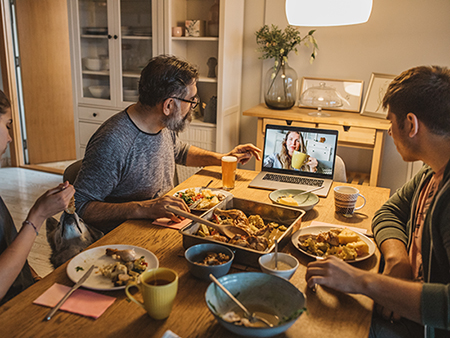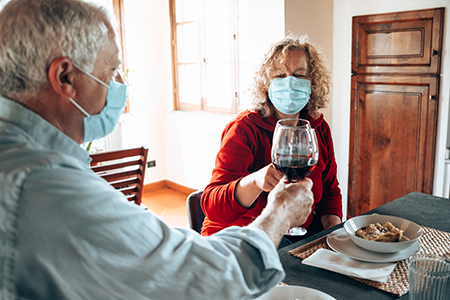Media contact: Savannah Koplon
Editor's Note: The information published in this story is accurate at the time of publication. Always refer to uab.edu/uabunited for UAB's current guidelines and recommendations relating to COVID-19.
Thanksgiving is a time when families and friends gather to celebrate the season together. Traditions often include sharing meals around a table, shopping, watching football games, and traveling to visit loved ones from near and far.
As the holiday approaches, families are concerned about what the COVID-19 pandemic means for their annual family gathering. Is Thanksgiving as we know it safe to do this year?
“Gathering ‘as usual’ for Thanksgiving traditions could be especially dangerous this year as this type of event has the potential to transmit COVID,” said Ellen Eaton, assistant professor in the University of Alabama at Birmingham Division of Infectious Diseases. “Unfortunately, most Thanksgiving activities like eating and talking are usually done indoors and without masks. They are a perfect environment to spread COVID-19 across multiple attendees.”
Knowing that COVID-19 spreads through the air and in close-contact situations, usually indoors, how can people safety congregate and spend time with one another on the third Thursday in November? Can you share meals? What about eating indoors? Enjoying tradition can still be achievable — albeit different — according to experts from UAB and the Centers for Disease Control.
The CDC has specific activities listed as high-risk and offers alternatives for this year.
Safe practices for Thanksgiving 2020
This Thanksgiving, experts urge it is critical to:
- Wear a mask around others and when indoors
- Practice social distancing of 6 feet with those not from your immediate household
- Wash hands before, during and after events
- Sanitize hands frequently throughout the day and while around others
- Cancel attending any in-person gatherings if you or someone in your home has any symptoms of COVID-19
- Limit gatherings to five people, other than immediate household members (suggested)
- Move all activities outside
- Get your flu shot at least two weeks before Thanksgiving as an optimal way of minimizing the possibility of flu being present too
“If you or your loved ones fall into high-risk groups, help stay connected by incorporating remote or virtual elements into your celebrations, or even nontraditional activities for the day,” said Bertha Hidalgo, associate professor in the UAB School of Public Health.
This could include having Zoom or FaceTime dinners or planning outdoor activities with loved ones that do not revolve around eating and situations where masks may be removed.
Hidalgo encourages folks to consider factors like these when planning for the Thanksgiving holiday:
- Who will be at the event? Will there be more than 10 people? Are those people abiding by lifestyles and rules during the pandemic similar to yours and those of your family?
- Where will the event be? Can it be outdoors or have outdoor components?
- How much time is spent with people?
- How much space is available, and can you social distance?
 Thanksgiving will be different this year because of the coronavirus pandemic, but a safe celebration is still possible with the help of guidelines laid out by UAB experts and the CDC.How to share a safe Thanksgiving meal
Thanksgiving will be different this year because of the coronavirus pandemic, but a safe celebration is still possible with the help of guidelines laid out by UAB experts and the CDC.How to share a safe Thanksgiving meal
Shared meals are discouraged, but you can consider having others bring their own snack and beverage for individual consumption. If a family chooses to move forward with a traditional seated and food-centered gathering, experts recommend the following tips be strongly considered:
- Plan ahead and make your COVID-19 precautions clear so that your guests have reasonable expectations.
- Station the food and tables for eating outside where there is ample ventilation; ask guests to bring their own blankets if it is a chillier day.
- Pre-portion meals instead of having a buffet-style setup to minimize touching of items.
- Limit the number of cooks. A single cook is recommended to prepare meals; this may not be the year for potluck-style meals.
- Use pre-packaged or pre-set silverware.
“When eating or drinking together, masks obviously have to come off. For this reason, you may want to skip the meal entirely. But if you are planning a meal with guests from outside your household, replace masks with physical distancing while you eat,” Hidalgo said.
Having a gathering indoors is highly discouraged this year; but if indoor seating is the only option, following these guidelines will help:
- Ensure social distancing by seating people at every other seat.
- Keep immediate household family members bunched together instead of separating to mingle with others.
- Set up tables across different rooms to spread people out.
- Open windows to ensure ventilation.
- Have extra masks for anyone who forgets theirs, and make sure there is plenty of soap in your bathroom and hand sanitizer easily available.
High-risk activities:
- Traveling, by plane or long distances
- Shopping at crowded malls
- Anything that occurs within 6 feet, without a mask or with members outside of your household
- Eating or sharing drinks while sitting around a table
- Sitting around a TV watching your team play football
- Carpooling with those not in your household
“Using creative activities outdoors, we can dramatically reduce the risk of transmission,” Eaton said. “This year, we are going to be creative to support one another over the holidays without getting our loved ones ill or worse.”
Alternative activities:
- Have a small dinner with members of your immediate household
- Watch football at home with members of your immediate household
- Outdoor “Turkey Trot” run or hike with immediate household members
- Arrange an outdoor, distanced visit to see elderly or immunocompromised relatives
- Have a virtual dinner and share recipes with friends and family
- Shop online
 Thanksgiving is a time when families and friends gather to celebrate the season together. Traditions often include sharing meals around a table, shopping, watching football games, and traveling to visit loved ones from near and far.The need for smaller, more intimate gatherings will not last forever. And, it can allow us to connect in a more intimate way with a smaller group, experts say. So rather than dinner indoors with your five grown children and their families, it is much safer to gather with one family at a time, outdoors, perhaps over a cup of coffee or hot chocolate and s’mores over a fire pit.
Thanksgiving is a time when families and friends gather to celebrate the season together. Traditions often include sharing meals around a table, shopping, watching football games, and traveling to visit loved ones from near and far.The need for smaller, more intimate gatherings will not last forever. And, it can allow us to connect in a more intimate way with a smaller group, experts say. So rather than dinner indoors with your five grown children and their families, it is much safer to gather with one family at a time, outdoors, perhaps over a cup of coffee or hot chocolate and s’mores over a fire pit.
Eaton reassures us that we will get beyond this chapter, and there will be time to reunite with our loved ones to share long, leisurely holiday traditions again.
“We will do Thanksgiving again and resume the traditions that make up the framework of our families,” she said. “But it won’t be in 2020, and it shouldn’t be. Let’s work to keep those whom we love and cherish the most safe this season.”
To learn more about UAB COVID safety guidelines and initiatives, visit UAB United.
